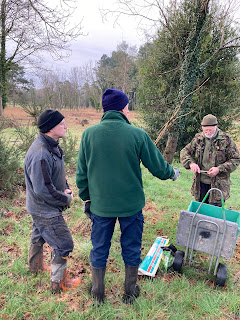Boundary House Fen, Frilford Heath Golf Course SSSI - Saturday, 24 February 2024
Blog by Sally, photos by Kevin and Sally
We returned to Boundary House Fen at Frilford Heath Golf Course this week to continue with the cut and rake, working under the direction of consultant ecologist, Rod d'Ayala. Kevin led a team of 10 Green Gymmers - 4 trained scythers and 6 rakers. Kevin had arrived to find that the gate to the Greenkeepers compound had not been opened, so after a call to the clubhouse, the gate was opened. Kevin dropped Carolyn off to greet everyone and when we had assembled we made our way across the golf course. We could hear a couple of skylarks singing as we approached the fen. Kevin had parked off the road nearer the fen to make it easier for him and Graham to transport the tools to our usual spot near the fen. By the time we got there, Rod had joined us and was able to show where on the fen we would be working and what we'd be doing.
Rod had managed to rake a good amount after our last session at the site, but there was still some raking to be done. He set off with the rakers in tow, whilst the four scythers were asked to continue with the cut of common reed, rush and sedge, taking care to avoid areas that were thick with marsh lousewort, in case it had not distributed all its seed. Marsh lousewort is a wonderful plant that is an ecosystem engineer. It feeds off the sugars stored in the reeds' roots, thereby suppressing its vigour. The reed, rush and sedge can all, if left unchecked, grow very densely, thereby blocking out light for other fen specialist plants. Barbara was asked to scythe along the "stream" which is acting as a ditch, whilst the other three scythers continued cutting towards the two man-made ponds.
We were all able to negotiate the stream, which has been packed with cut reed, rush and sedge so we could step into the middle without getting a bootful of water! The fen was very slushy in places and we were careful not to get stuck or plastered in mud.
The cut material was taken to a heap running along the top of the boundary with the aim to pile it high and then Rod would flatten it so that more cut reed could be piled on top.
There had been an overnight frost, so we had a bit of a chilly start, but once we got going, we soon warmed up and gradually, peeled off layers of clothing, making use of one of the tree stumps in the middle of the fen as a makeshift clothes horse. As the morning progressed, the sun broke through and it began to feel like spring again.
After a welcome break, we returned to continue and we soon reached the two ponds which we were able to start to fill and to return the fen to its former glory. Depending on the number of volunteers on our next visit, we hope to finish the cut and rake for this season and it will be interesting to see what plants come through as the site is home to a number of species of orchid, amongst other calcareous fen specialists.
It was soon time to pack up and go. We said farewell to Rod and made way home all feeling as though a good job had been done. We look forward to returning at the end of April.





















Comments
Post a Comment